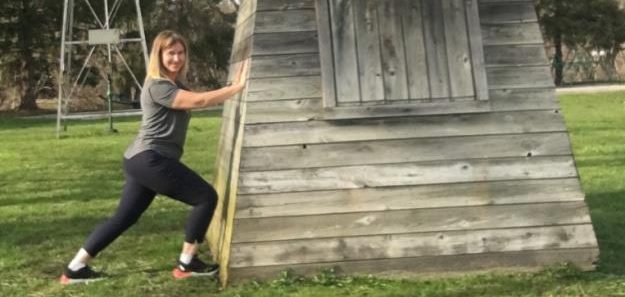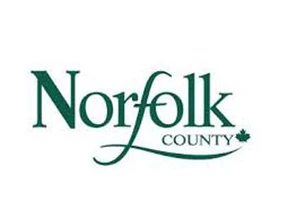“Sitting is the new smoking,” a phrase coined by Dr. James Levine to raise awareness of the toll prolonged sitting plays on our body. There are many problems associated with spending hours with our derriere in a chair, but today we’re going to focus on how tight calf muscles can wreak havoc with our feet.
It’s not natural for our body to sit in one place for several hours. We often sit with our knees bent and feet extended causing the calf muscles and Achilles to shorten. If your calves are tight and inflexible it restricts your ability to walk correctly. Have you ever stood up at the end of the day and felt like the Tin man who has lost his oil can?
There are two major muscles that make up our calves. They are the Gastrocnemius and the Soleus muscles. Both run from the back of your knee and attach at the heel via your Achilles tendon. The calf muscle plantar flexes the ankle joint. Plantar flexion is the action of pointing your toes, standing on tippy toes, or lifting the heels and pressing into the ball of the foot as we walk. The Achilles tendon is attached to your calf muscle, so it is no wonder that when calves are tight, that it can lead to Achilles tendonitis, which is inflammation and tiny tears in the tendon. The Achilles tendon also attaches to the plantar fascia which is a band of tissue that stretches across the sole of your foot. If this tissue becomes inflamed, it can lead to the searing heel pain commonly associated with Plantar Fasciitis. Tight calf muscles limit the range of motion in your ankles, which causes some people to place more pressure on the balls of their feet when they walk or stand. If you spend much of the day standing, the extra strain to the forefoot can lead to problems like bursitis, nerve entrapment or capsulitis, which is often referred to as metatarsalgia. This is a condition where the ball of the foot becomes painful and inflamed. Pain in the big toe joint, and hammer toe deformities, can all be the result of the tight calf muscle.
Spending hours on our feet is better than sitting, but as you can see it still may result in foot pain especially as we age because collagen production slows down and we have less cushioning on the balls of our feet and heels. Standing is a passive activity which means it does not stimulate circulation. Having less blood flow to your feet on a regular basis over a prolonged period of time can cause sore feet, swelling of the legs, varicose veins, and general muscular fatigue.
“Basically, the body does not like to have the same posture or load placed on it continuously, so change is always good. You want routine breaks where you get the blood moving’ says Kermit Davis, graduate program director for environmental and occupational hygiene at the University of Cincinnati. Switching up your routine during the day is the best option. Alternate your activities between sitting and standing, and take several breaks, even micro breaks to walk or stretch whenever you can.
Below are a few simple stretches to help those achy feet. Stretching should be to the
point of stimulation. Stretching may feel uncomfortable, but it should never be painful.
Hold each stretch for at least thirty seconds to give the muscle fibers time to relax. You
get the best results if you repeat each stretch at least three times during the day. Be
certain to breathe when stretching to keep your blood pressure from spiking. With each
exhale, go a little bit deeper into the stretch. When you breathe properly, your heart
pumps oxygenated blood to your muscles.
Gastrocnemius Stretch
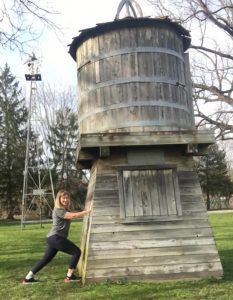
The Gastrocnemius muscle assists in bending the knee and helps keep you balanced
and upright. The Gastrocnemius stretch targets the calf muscle that starts above the
knee so your back leg should be straight during this stretch. Start with your hands
leaning on a counter top, table or wall and take a big step back. The longer the step, the
more you will feel the stretch. Check that your knees and toes are pointing forward as
you place your weight on the back leg making certain the heel is anchored. Gradually
transfer your weight to your front leg bending a little further into the front knee for a
deeper stretch. You may want to try variations of this stretch with the toe of the back
leg pointed in towards the other foot or outwards away from the foot.
Soleus Stretch
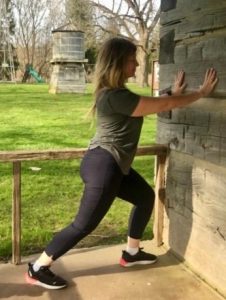
The Soleus muscle starts just below the knee. We target this part of the calf by bending
the knee while stretching. This stretch is performed in the same position as the first
stretch only this time we place the weight in the back leg, anchor the back heel, then
bend the knee until you feel a stretch through the calf and Achilles.
Heel Drop
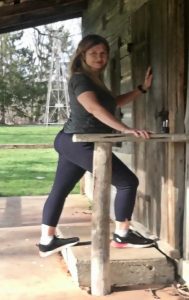
Start by placing the ball of the foot on the lower step with the heel resting off the back
of the step. Drop the heel down by slightly bending the top knee until you feel a stretch
in your calf.
A great natural way to lengthen calf muscles is to add some small hills to your daily
walk. When we walk up a hill it naturally lengthens the muscles of the lower leg and
ankle. Kids rarely have foot problems, probably because they hate sitting still. Children
love to move, climb trees, hills, monkey bars etc. Moving keeps us pliable and healthy.
In the words of George Bernard Shaw, “We don’t stop playing because we grow old; we
grow old because we stop playing.”

